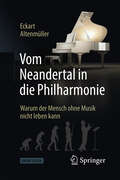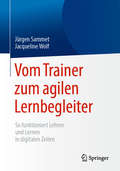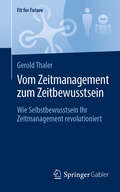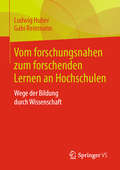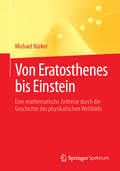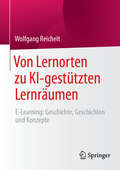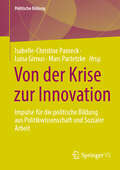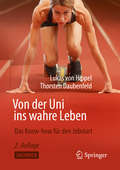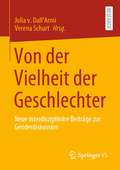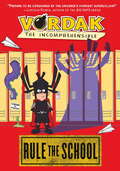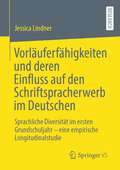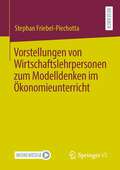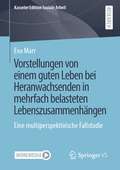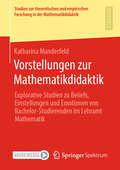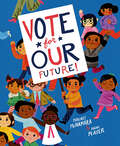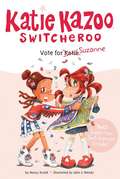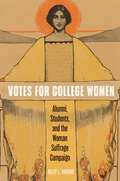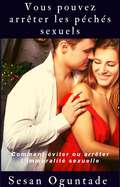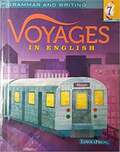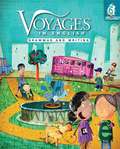- Table View
- List View
Vom Neandertal in die Philharmonie: Warum der Mensch ohne Musik nicht leben kann
by Eckart AltenmüllerWarum haben wir Menschen Musik? Wie entfaltet Musik ihre Wirkung? Was geht dabei in unserem Gehirn vor? Fördert Musik die Intelligenz? Dient sie dem Gruppenzusammenhalt? Teilt Musik Emotionen mit? Dieses Buch erklärt die zahlreichen Wirkungen von Musik auf Fühlen und Denken, auf die Organisation von Gruppen sowie auf unsere körperliche und geistige Gesundheit. Im ersten Teil des Werkes werden die evolutionären Grundlagen der Musikwahrnehmung und des Musizierens dargestellt. Die faszinierenden neuen Erkenntnisse zu den positiven, aber auch den negativen Auswirkungen intensiven Musizierens auf das Nervensystem werden in den folgenden Kapiteln geschildert. Glücklicherweise macht Musik nur selten krank – viel wichtiger sind die bislang noch gar nicht ausgeschöpften heilenden Potenziale und die große Macht der positiven Emotionen, die durch Musik ausgelöst werden. Mit diesen erfreulichen und zukunftsweisenden Aspekten schließt das Buch, das jeden ansprechen wird, der eine Liebe zur Musik empfindet, sei es als Musizierender oder als Hörer.
Vom Trainer zum agilen Lernbegleiter: So funktioniert Lehren und Lernen in digitalen Zeiten
by Jacqueline Wolf Jürgen SammetReine Präsenztrainings werden immer mehr ergänzt oder gar abgelöst durch moderne Lernformen wie Blended Learning, Online-Trainings, E-Learning und informellem Lernen. Was bedeutet dies für Sie als Trainer (Dozent, Referent, Personalentwickler)?Dieses Fachbuch zeigt auf, wie sich das Berufsbild des Trainers durch die Digitalisierung ändert und welche Kompetenzen Sie als Trainer benötigen, um in der „Learning Revolution“ erfolgreich zu sein. Denn: Fachwissen gepaart mit Präsenzdidaktik reichen hier nicht mehr aus.Dieses Werk nimmt Sie an der Hand, um als Trainer selbst wieder Lerner zu werden und sich zum „agilen Lernbegleiter“ weiterzuentwickeln. Es gibt Ihnen eine Orientierung im digitalen „Trainerkompetenz-Dschungel“. Praxistauglich und klar verständlich erhalten Sie sowohl theoretisches Hintergrundwissen als auch praktische Umsetzungsmöglichkeiten für die Modernisierung Ihres Weiterbildungsangebots.
Vom Wesen der deutschen Universität (René König Schriften. Ausgabe letzter Hand #2)
by René KönigRené Königs Buch "Vom Wesen der deutschen Universität" schildert beredt die hochschulpolitischen Anschauungen klassischer deutscher Denker. Fichte und Schelling, Schleiermacher und Humboldt werden daraufhin befragt, inwieweit ihre Überlegungen über den aktuellen Anlass hinaus Geltung für spätere Epochen beanspruchen dürfen.
Vom Zeitmanagement zum Zeitbewusstsein: Wie Selbstbewusstsein Ihr Zeitmanagement revolutioniert (Fit for Future)
by Gerold ThalerDieses Buch richtet sich an junge Erwachsene und Berufseinsteiger, die Orientierung suchen, an ihrem Selbstbewusstsein zweifeln oder sich von der Geschwindigkeit des Lebens überfordert fühlen. Es zeigt, wie Sie Selbstvertrauen systematisch aufbauen und dadurch ein zeitbewusstes Leben führen können – ohne darauf zu warten, dass ein Schicksalsschlag oder eine Krise Sie dazu zwingt. Selbstbewusstsein ist die Grundlage für selbstbestimmte Entscheidungen und die Fähigkeit, mit Stress und der Schnelllebigkeit der modernen Arbeitswelt umzugehen. Dieses Buch beleuchtet, warum Zeit unsere wertvollste Ressource ist und wie wir lernen können, Herausforderungen des Alltags besser zu meistern. Es gibt praktische Einblicke in Themen wie Resilienz und den Umgang mit Zukunftsängsten. Die zentrale Botschaft verdeutlicht: Selbstbewusstsein ist die Basis unserer persönlichen Produktivität und lässt sich steigern! Mit persönlichen Geschichten und wissenschaftlichen Erkenntnissen inspiriert dieses Buch zu einem Leben, in dem Sie nicht nur Zeit managen, sondern bewusst gestalten. Denn: Es lässt sich leichter leben, wenn Sie zeitbewusst leben. Starten Sie jetzt Ihre Reise zu einem zeitbewussten Leben!
Vom forschungsnahen zum forschenden Lernen an Hochschulen: Wege der Bildung durch Wissenschaft
by Gabi Reinmann Ludwig HuberDas Buch liefert eine durchgängige und kohärente Orientierung zu forschungsnahem und forschendem Lernen. Es unternimmt den Versuch, die zahlreich vorhandenen Modelle, typische Erfahrungen und praktische Empfehlungen zu bündeln und aufeinander zu beziehen. Als Monografie zweier hochschuldidaktisch tätiger Wissenschaftler bietet das Buch eine komplementäre Lektüre zu den zahlreichen Artikeln in Sammelbänden und Zeitschriften über die Verbindung von Forschung und Lehre.
Von Eratosthenes bis Einstein: Eine mathematische Zeitreise durch die Geschichte des physikalischen Weltbilds
by Michael BürkerDer Buchtitel Von Eratosthenes bis Einstein deutet einen großen Bogen an, der in einer mathematischen Zeitreise durchlaufen wird. Das Buch wendet sich an Studierende und an Personen, welche mehr über die Geschichte unseres Weltbilds von der Antike bis zur Gegenwart im Zusammenhang mit den Biografien der Protagonisten erfahren wollen. In der Antike sind dies Denker, welche nach rationalen Ursachen der Naturerscheinungen fragen und rationale Antworten versuchen, und Denker, welche Philosophie, Mathematik und Astronomie zu einer ersten Blüte bringen. In der Renaissance und Neuzeit weisen Kopernikus mit dem heliozentrischen Weltbild sowie Galilei und Kepler mit einer neuen Verknüpfung von Empirie und mathematisch geprägter Theorie den Weg zu naturwissenschaftlichem Denken, vollendet Isaac Newton mit einer tieferen Begründung und Mathematisierung der Physik die kopernikanische Wende und eröffnet gleichzeitig eine Forschungs- und Wissensvielfalt ohnegleichen. Schließlich legen Planck mit der Quantentheorie und Einstein mit den beiden Relativitätstheorien die Grundlagen unseres heutigen Weltbilds, in dem die Urknalltheorie den Beginn unserer Raumzeit vor etwa 14 Milliarden Jahren anzeigt, aber auch die Frage aufkommt, ob hinter der Entwicklung des Universums, wie wir es heute verstehen, eine zielgerichtete Strategie hin zur Existenz des Menschen steckt oder ob diese Entwicklung ein bloßer Zufall äußerst geringer Wahrscheinlichkeit ist.
Von Lernorten zu KI-gestützten Lernräumen: E-Learning: Geschichte, Geschichten und Konzepte
by Wolfgang ReicheltDie Digitalisierung von Bildungsprozessen ist eine der wichtigsten gesellschaftlichen Aufgaben des 21. Jahrhunderts. Spätestens die Corona-Pandemie hat das nicht nur den Unternehmen, sondern auch den Schulen, Berufsschulen und allen weiteren Bildungsträgern teilweise ziemlich schmerzhaft vor Augen geführt. Doch worauf kommt es eigentlich an, wenn man Bildungsprozesse digitalisieren möchte? Wolfgang Reichelt zeigt in seinem mit amüsanten Anekdoten gespickten autobiographischen Rückblick auf 40 Jahre E-Learning: Nach wie vor kommt es auf die Basics an!
Von der Krise zur Innovation: Impulse für die politische Bildung aus Politikwissenschaft und Sozialer Arbeit (Politische Bildung)
by Marc Partetzke Isabelle-Christine Panreck Luisa GirnusDas Buch bietet einen breiten Überblick aktueller Forschung über Krisen und Innovationen der Gegenwart und ihre Konsequenzen für die politische Bildung. Mit interdisziplinärem Anspruch analysieren Forschende u. a. aus Politikwissenschaft und Sozialer Arbeit gesellschaftliche Herausforderungen ebenso wie neue Lösungsansätze innerhalb formaler und non-formaler Bildungsangebote und ihrer sozialen Kontexte. Im Mittelpunkt stehen hierbei Fragen der Partizipation und Teilhabe, der Verbindung schulischer und außerschulischer Bildungsorte und der Politikdidaktik. Der Band richtet sich an Forschende, Studierende sowie Praktiker*innen der politischen Bildung.
Von der Uni ins wahre Leben: Das Know-how für den Jobstart
by Thorsten Daubenfeld Lukas von HippelAbsolventen möchten möglichst schnell Erfolge verzeichnen, Unternehmen möglichst schnell erfolgreiche Mitarbeiter. Im Fächerkanon einer Hochschulausbildung fehlen jedoch oft die Teilgebiete, die für die Karriere wichtig sind, wie zum Beispiel entscheidende Soft Skills oder notwendige Kenntnisse im Bereich Wirtschaft und Finanzen. Lukas von Hippel und Thorsten Daubenfeld berichten aus eigener Erfahrung und geben eine komprimierte Einführung in allgemein berufsrelevante Kompetenzen. Dass viele dieser Kenntnisse auch das Privatleben erfolgreicher machen können, ist ein erfreulicher Nebeneffekt. Das Buch enthält zahlreiche anschauliche Beispiele und wendet sich an Absolventen sowie an Berufseinsteiger.
Von der Vielheit der Geschlechter: Neue interdisziplinäre Beiträge zur Genderdiskussion
by Julia V. Dall'Armi Verena SchurtDer Sammelband nähert sich dem Thema auf interdisziplinärer Ebene und vereint aktuelle deutschdidaktische wie erziehungswissenschaftliche Beiträge zu Vermittlungs- und Aneignungsprozessen von Genderkonzeptionen. Enthalten sind theoretische Grundlagenbeiträge und auch konkrete Beispiele, die aktuelle Genderfragen sowohl kritisch als auch konstruktiv beleuchten. Aus der Perspektive der Erziehungswissenschaft steht zunächst die Frage nach der Bedeutsamkeit des Umgangs mit "Geschlecht" in Schule, Kindergarten und Elternhaus im Fokus des Bandes. Von dieser allgemeinen Grundlegung ausgehend werden exemplarisch weitere, die Sozialisation von Kindern wie Heranwachsenden prägende (Bildungs-)Angebote in den Blick genommen. So wird beispielsweise die Vermittlung literatur- und mediendidaktischer Genderkonzeption gezeigt, etwa die mediale Darstellung von Geschlechterrollen mit Fokus auf ihre Funktionalisierbarkeit im Unterricht. Aber auch der aktuellste Stand sprachbezogener Aspekte, die in die Erziehung zu einem gendersensiblen Sprachgebrauch münden können, hat Eingang in den Sammelband gefunden.
Voorlichting en advies in de tandartspraktijk (Basiswerk AG)
by Rianne Schotsman Nienke van OsDit studieboek biedt een theoretische basis voor het geven van voorlichting en advies door de tandartsassistent. De auteurs gaan in op het proces van gedragsverandering aan de hand van het zogeheten Model van Balm. Dit model is leidend in dit boek en uitermate geschikt om te gebruiken tijdens het geven van voorlichting, instructie en advies in de tandartspraktijk om gedragsverandering teweeg te brengen. Het geven van voorlichting en advies wordt voor de tandartsassistent steeds belangrijker. Voorlichten lijkt op papier vrij simpel, in de praktijk is het nog niet zo eenvoudig. Iedere patiënt is anders en ieder probleem is anders. Met behulp van Voorlichting en advies in de tandartspraktijk kan de tandartsassistent uitleg en advies geven over bijvoorbeeld het voorkomen van tandheelkundige problemen, het bevorderen van mondgezondheid, mondzorgproducten, tandheelkundige voorzieningen en tandheelkundige behandelingen. Met behulp van casuïstiek worden situaties verduidelijkt. Rianne Schotsman en Nienke van Os zijn beiden mondhygiënist en docent. Zij hebben jarenlang samengewerkt aan de opleiding voor tandartsassistenten in Utrecht. Momenteel is Rianne Schotsman verbonden aan ROC Nijmegen als onderwijsadviseur Leven Lang Ontwikkelen (LLO). Nienke van Os is werkzaam als zelfstandig learning specialist en ontwerpt en ontwikkelt educatieve content en e-learnings voor onderwijsinstellingen en bedrijven.
Vordak the Incomprehensible: Rule the School
by Vordak T. IncomprehensibleGreetings, goobers! After my latest experiment worked a little too well—transforming my rather fetching figure into something significantly smaller—I’ve been forced to return to those halls of horror better known as . . . school. But going back to junior high may be my greatest opportunity for mayhem in many a month! Try to keep up as I: • Dramatically defeat the daily dangers of schooldom—even though everyone is against me. • Strive to win the junior high presidential election by alerting my fellow students to the wonderfulness of Vordak the Incomprehensible, as well as the yuck-ness of my opponent, Marlena Lurchburger. • Mastermind a catastrophic career day, where that disgusting do-gooder Commander Virtue will finally, fiendishly be foiled. Fortunately for you, I have recorded every mischievous moment within these carefully crafted covers so that you may bask in my brilliance as I plot to RULE THE SCHOOL . . . and, eventually, THE WORLD! MUAHAHAHAHA!!!
Vorläuferfähigkeiten und deren Einfluss auf den Schriftspracherwerb im Deutschen: Sprachliche Diversität im ersten Grundschuljahr – eine empirische Longitudinalstudie
by Jessica LindnerDas Buch thematisiert die Ausprägung spezifischer Vorläuferfähigkeiten (rezeptive und produktive gesprochen-sprachliche Fähigkeiten sowie Kompetenzen im Bereich der phonologischen Informationsverarbeitung (phonologische Bewusstheit, Benennungsgeschwindigkeit)) und deren Einfluss auf den Schriftspracherwerb im Deutschen im Kontext des monolingualen und bilingualen Erstspracherwerbs sowie des Zweitspracherwerbs. Die empirische Longitudinalstudie zweier Kohorten im ersten Grundschuljahr berücksichtigt neben der sprachlichen Diversität der Kinder auch die besondere Beschulungssituation im Rahmen der COVID-19-Pandemie.
Vorstellungen von Wirtschaftslehrpersonen zum Modelldenken im Ökonomieunterricht
by Stephan Friebel-PiechottaStephan Friebel-Piechotta untersucht in der vorliegenden Studie die Vorstellungen von Wirtschaftslehrpersonen zum Denken in ökonomischen Modellen sowie zum Lehren und Lernen mit und über ökonomische(n) Modelle(n) im Wirtschaftsunterricht. Im theoretischen Teil der Arbeit wird das Modelldenken im Wirtschaftsunterricht konzeptionell aufgearbeitet. Im Rahmen der darauf aufbauenden qualitativen Interviewstudie werden die Vorstellungen der Lehrpersonen erhoben und analysiert. Hierbei werden auch die Unterschiede zwischen den Vorstellungen der Lehrpersonen und dem theoretischen Referenzrahmen zum Modelldenken im Wirtschaftsunterricht herausgearbeitet.
Vorstellungen von einem guten Leben bei Heranwachsenden in mehrfach belasteten Lebenszusammenhängen: Eine multiperspektivische Fallstudie (Kasseler Edition Soziale Arbeit #24)
by Eva MarrEva Marr untersucht Vorstellungen von einem guten Leben aus der Perspektive von Kindern und Jugendlichen, die Hilfen zur Erziehung gemäß §§ 27-35/35a SGB VIII in Anspruch nehmen und gleichzeitig einen kinderpsychiatrischen bzw. -psychologischen Behandlungsbedarf aufweisen. Mit der qualitativen Studie wird dem Desiderat begegnet, dass bislang die Perspektiven von mehrfach belasteten Mädchen und Jungen auf ihre Lebenswirklichkeit kaum erforscht worden sind. Anhand von drei Fallstudien werden biografie- und situationsanalytisch Entstehungsweisen, Bedingungen und Repräsentationsformen der Vorstellungen von einem guten Leben der Kinder und Jugendlichen untersucht, unter Einbezug der Perspektiven von Akteur*innen aus deren sozialen Nahbeziehungen sowie von professionellen Akteur*innen an den Schnittstellen fachübergreifender institutioneller Versorgung von Kinder- und Jugendhilfe, Schule und Kinder- und Jugendlichenpsychotherapie/-psychiatrie. Die Vorstellungen der Kinder und Jugendlichen von einem guten Leben werden in einem theoretischen Modell vernetzter und dynamischer Dimensionen gefasst, die sich im Lebenslauf relational zu den Erfahrungen und dem Erleben der Heranwachsenden bilden, prozesshaft verändern und für die Handlungspraxis Ressourcen eröffnen.
Vorstellungen zur Mathematikdidaktik: Explorative Studien zu Beliefs, Einstellungen und Emotionen von Bachelor-Studierenden im Lehramt Mathematik (Studien zur theoretischen und empirischen Forschung in der Mathematikdidaktik)
by Katharina ManderfeldKonstruktivistische Lerntheorien legen nahe, dass das mathematikdidaktische Lernen von Studierenden abhängig davon ist, welche Vorstellungen sie von Mathematikdidaktik besitzen. Das sich hieraus ergebende hochschuldidaktische Interesse, die studentischen Vorstellungen zur Mathematikdidaktik zu beforschen, wird mithilfe eines Mixed-Methods-Designs umgesetzt. In einer Fragebogenstudie werden Typen unterschiedlicher Vorstellungen gebildet. Mithilfe von Leitfadeninterviews werden anschließend tiefere Einblicke in die Vorstellungen einzelner Vertreterinnen und Vertretern der Typen erlangt. Die Ergebnisse beider Studien werden in vier Vorstellungen zur Mathematikdidaktik zusammengeführt, aus deren Betrachtung Handlungsoptionen zur Verbesserung der hochschulischen Lehre abgeleitet werden können.
Vote for Our Future!
by Margaret McNamaraIn this charming and powerful picture book about voting and elections, the students of Stanton Elementary School learn how we can find--and use--our voices for change. Every two years, on the first Tuesday of November, Stanton Elementary School closes for the day. For vacation? Nope! For repairs? No way! Stanton Elementary School closes so that it can transform itself into a polling station. People can come from all over to vote for the people who will make laws for the country. Sure, the Stanton Elementary School students might be too young to vote themselves, but that doesn't mean they can't encourage their parents, friends, and family to vote! After all, voting is how this country sees change--and by voting today, we can inspire tomorrow's voters to change the future.
Vote for Suzanne (Katie Kazoo Switcheroo Super Special #7)
by Nancy KrulikEveryone in Cherrydale has election fever! While the adults get ready to vote for town mayor, the fourth graders are holding an election for a fourth grade mayor! Both Katie and Suzanne are nominated, and Suzanne really wants to win.
Vote! (The Complicated Life of Claudia Cristina Cortez)
by Diana GallagherHumorous first-person narratives. These honest, humorous, and hopeful stories, told by Claudia herself, give readers a glimpse into the life of a regular 21st-century girl. Claudia handles every situation with confidence, cleverness, and a serious dash of cool.
Vote!: The Complicated Life of Claudia Cristina Cortez (Claudia Cristina Cortez)
by Diana G GallagherHumorous first-person narratives. These honest, humorous, and hopeful stories, told by Claudia herself, give readers a glimpse into the life of a regular 21st-century girl. Claudia handles every situation with confidence, cleverness, and a serious dash of cool.
Votes for College Women: Alumni, Students, and the Woman Suffrage Campaign
by Kelly L. MarinoExplores the College Equal Suffrage League’s work to advance the campaign for the Nineteenth AmendmentThe woman suffrage movement is often portrayed as having been led and organized by middle-aged women and mothers in stuffy, formal settings. This dominant account grossly neglects a significant demographic within the movement—college women. Between 1870 and 1910, the proportion of college women in the United States rose from 21 to 40 percent. By 1880, there were 155 private colleges in the Northeast and the South for female students and numerous coeducational institutions in the West. The widespread extension of academic training for women helped spur a well-organized campaign for female voting rights on college campuses, where suffragists found a new audience and stage to earn respect and support.Votes for College Women examines archives from the College Equal Suffrage League (CESL), established in 1900 as an affiliate of the National American Woman Suffrage Association, to illustrate the outsize and dynamic role that young women played in the woman suffrage movement. The book vividly illustrates how the CESL’s campaigns served a dual purpose: not only did they invigorate the Nineteenth Amendment campaign at a crucial moment, but they also brought about a profound transformation in the culture of women’s organizing and higher education. Furthermore, Kelly L. Marino argues that the CESL’s campaigns set trends in youth activism and helped lay the groundwork for later and more well-known college protests against gender inequality. Fascinating and timely, Votes for College Women shows how these brave women solidified the campus and the classroom as arenas for civic and social activism.
Vous pouvez arrêter les péchés sexuels.: Comment éviter ou arrêter l’immoralité sexuelle
by Sesan OgunotadeCeci s’adresse aux adolescents et aux jeunes de tous sexes, aux hommes et femmes mariés (qui désirent être fidèles à leur conjoint), aux parents (qui cherchent un guide pour enseigner la pureté sexuelle à leurs adolescents à la maison), aux écoles et autres agences éducatives, ainsi qu’aux organisations religieuses.
Voyages In English: Writing and Grammar Grade 6
by Ihm SistersOur Voyages in English Student Edition engages students with varied learning styles and allows teachers to adapt lessons to help meet all students’ needs in an easy-to-use, student-friendly format. The program is divided into two distinct parts—Part 1: Written and Oral Communication, and Part 2: Grammar—with integration opportunities built in. This way, teachers can reinforce the important relationships between grammar, writing, and speaking.
Voyages in English Grade 7: Grammar and Writing
by Mary Ellen Patricia Healey Adrienne Saybolt Anne McGuire Danielle Truex Emily AnnVoyages in English: Grammar and Writing, Grade 7, Student Edition
Voyages in English: Grammar and Writing (6th Grade)
by Patricia Healey Irene Kervick Anne B. Mcguire Adrienne SayboltThis book of "Voyages in English 2011" enables children to master grammar through direct instruction, rigorous practice, written application, and ongoing assessment. It provides master and novice teachers with support and straightforward, practical lesson plans that can be presented with confidence.
